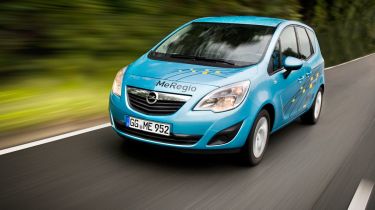Vauxhall Meriva EV
An Electric version of Vauxhall's supermini-MPV that repackages the battery technology from the Ampera - but how does it cope being driven like a normal car?

The electric Meriva isn’t destined for production just yet, but the fact the Ampera’s hi-tech battery can be repackaged so easily into other body shapes is a promising sign of things to come. It’s silent, smooth and surprisingly quick, giving it a unique character next to a more conventional Meriva. The only real drawback is the limited range, but if you drive less than 40 miles a day, this would be an ideal low-cost family car.
Vauxhall’s secret electric Meriva has sparked into life! Engineers have taken the T-shaped battery pack from the Ampera and Chevrolet Volt and fitted it to the supermini-MPV – and Auto Express is first to try it.
Unlike the Ampera, there’s no range-extending petrol engine fitted here, and the battery is now split into three separate parts. That means its weight can be distributed equally throughout the car – under the bonnet, rear seats and boot. It also frees up space for a traditional three-seat rear bench, as opposed to the two in the Ampera.
Video: watch CarBuyer's video review of the Vauxhall Meriva
[[{"type":"media","view_mode":"content_narrow","fid":"68522","attributes":{"alt":"","class":"media-image"}}]]
Without the range extender engine, the Meriva EV can travel 40 miles on a single charge, with a top-up itself taking one hour from a 400-volt output, and three-and-a-half hours from a household socket. From the outside, it’s business as usual for the Meriva – save for the missing exhaust pipes. Inside, the changes are slightly more obvious.
Used - available now

2022 Kia
e-Niro
33,290 milesAutomaticElectric
Cash £20,197
2021 BMW
1 Series
60,610 milesAutomaticPetrol1.5L
Cash £17,697
2014 BMW
1 Series
130,000 milesManualDiesel2.0L
Cash £4,498
2014 Ford
C-Max
39,000 milesManualPetrol1.0L
Cash £4,898The rev counter has been replaced with a meter that shows how much energy is being used or regained through regenerative braking, and the fuel gauge has been substituted with a battery meter.
On the centre console, there’s an all-new start button and an interface which allows you to choose between the amount of energy recuperated under braking. Three settings (D–, D and D+) offer distinct driving experiences, thanks to different levels of engine braking when you take your foot off the throttle.
On the road, the electric MPV feels lively, with 0-62mph taking 11 seconds – that’s five-tenths quicker than in the 118bhp 1.4-litre turbocharged Meriva. The impressive performance comes down to the 215Nm of torque available instantly from zero rpm, and the fact that this model isn’t weighed down too much by bulky batteries.
It’s incredibly quiet, too. At low speeds, progress is almost silent. Our only gripe is with the steering, which offers far less feedback than on standard variants.
Vauxhall bosses admit that in the long-term, an electric Meriva makes a lot of sense. For the time being, though, this car remains a rolling laboratory as part of a German Government initiative to investigate how people use electric vehicles.
But it proves the technology is already at an advanced stage, and we could see a similar set-up in the all-electric Vauxhall Junior supermini, expected in 2014.
Rival: Nissan Leaf
With a claimed 100-mile range, the Leaf is the most practical electric car yet. But it takes eight hours to recharge and, at launch in March, will be far pricier than the average diesel family hatch.






